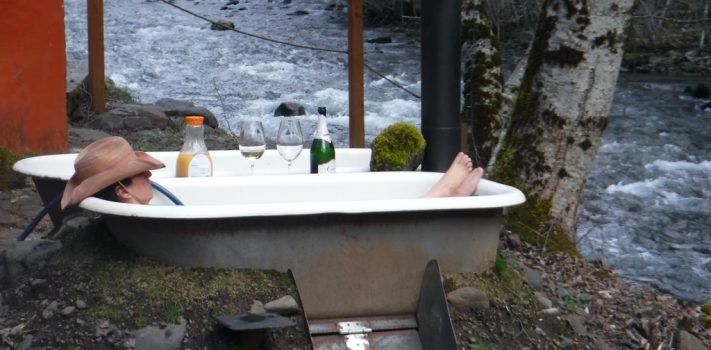Hygiene and clean clothes. When you first hear those words, they sound boring. Hygiene and clean clothes are not sexy like, “30-round magazines”, “Bug-Out-Bags”, or LP/OPs (listening posts/observation posts). They are not sexy. They are something more. They are essential.
When, not if, the grid goes down, you will want to wash your clothes and stay clean. I spent three years in Afghanistan and two years in Iraq as a military contractor. Having hot showers was a mini-vacation for us. When you’re outside in the elements continuously, it wears you down. When the grid goes down, the elderly and young will need to take care of things inside the house. The able-bodied men and women will need to be on guard duty, gardening, or other essential tasks. All of those activities will be outside in the elements, 24/7, 365 days a year. This will take a toll. A hot bath and clean clothes will be a mini-vacation that will rejuvenate you.
Hygiene and clean clothes are little things overlooked in the emergency preparedness community, but they will preserve health, increase morale, and sustain clothes. The force multiplier, (another one of those sexy words), for hygiene and clean clothes is a cowboy hot tub. Hot water heated in a cowboy hot tub can be used to wash your clothes and then wash your body with the same hot water.
A cowboy hot tub is an old antique cast iron claw-foot bathtub that has a fire made under it to heat water. We love our cowboy hot tubs on the river we live on. We don’t worry about hot tub chemicals or wasting electricity continuously heating the water.
A lot of farms around North America have livestock troughs made from their great grandparents’ old tubs. I’ve picked up several over the years driving by an old farm where livestock were drinking water from an old cast iron tub. Just knock on a farmer’s door and offer to buy them a new stock tank from a farm & ranch supply store in exchange for the old tub. It’s a win-win for both of you. You can also find them on Craigslist and Facebook marketplace.
Briefly, the trick to a cowboy hot tub is controlling the smoke and directing it out a chimney pipe. If you don’t contain and direct the campfire smoke, it will get in your eyes while you’re bathing. You can get away from campfire smoke in two ways. First, you can use a propane crab pot burner (jet burner) to heat the water. You heat the water and then turn the burner off when you get into the tub to bathe. While propane is available and relatively cheap, we use the crab pot burner. Second, when the grid goes down, we will be saving our propane for pressure-canning food. We will switch the cowboy hot tubs over to using firewood. To contain the campfire smoke, we constructed a cinder block burn box and set the tubs on top, for heating. Having a second tub provides a second water basin to rinse the soap off of the laundry.
The following is a quick cheat sheet on how to create a functional cowboy hot tub.
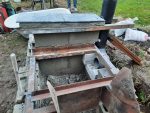 Clear an area near your water source. This area would be preferably with a nice view and away from fire hazards like brush or overhead trees. Dig a hole in a rectangle shape 30 inches long by 24 inches wide. The hole needs to be about 12” inches deep. Get roughly twenty to thirty classic cinder blocks and some mortar. Construct a box around this hole two to three blocks high. You need to have enough room under the tub to allow a crab pot burner with six to eight inches above it to the bottom of the tub. The bottom of the tub will be the top of the cinderblocks. You will make the burn basin in the shape of a capital “C” but with 90 degree corners.
Clear an area near your water source. This area would be preferably with a nice view and away from fire hazards like brush or overhead trees. Dig a hole in a rectangle shape 30 inches long by 24 inches wide. The hole needs to be about 12” inches deep. Get roughly twenty to thirty classic cinder blocks and some mortar. Construct a box around this hole two to three blocks high. You need to have enough room under the tub to allow a crab pot burner with six to eight inches above it to the bottom of the tub. The bottom of the tub will be the top of the cinderblocks. You will make the burn basin in the shape of a capital “C” but with 90 degree corners.
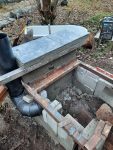 The empty area of the “C” is the entrance to the firebox to put your crab pot burner in and out. It will also be the area you will feed your wood fire if you are burning wood. You also need to leave a open 6 inch by 8 inch high area in the end of the “C” to run a six-inch diameter stove pipe out of. The 6×8 hole will be boxed in with cinder blocks. This will direct the smoke up the chimney pipe away from your face. The chimney will be placed at the drain side of the tub. The empty area of the “C” is to be located on one of the sides of the tub. You want to feed wood in through the side of the tub.
The empty area of the “C” is the entrance to the firebox to put your crab pot burner in and out. It will also be the area you will feed your wood fire if you are burning wood. You also need to leave a open 6 inch by 8 inch high area in the end of the “C” to run a six-inch diameter stove pipe out of. The 6×8 hole will be boxed in with cinder blocks. This will direct the smoke up the chimney pipe away from your face. The chimney will be placed at the drain side of the tub. The empty area of the “C” is to be located on one of the sides of the tub. You want to feed wood in through the side of the tub.
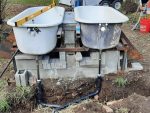 After this, place the tub on top of the cinder block firebox after the mortar has cured. Give it a day to dry. To keep the tub from rocking, shim up the tub by placing either some angled rocks or cinder block chunks in the crevasse of the tub bottom and firebox base. Mortar these in place. If you can salvage the drain on the tub, then attach a drainpipe to the tub. The last set of cowboy hot tubs I installed, I dug a trench at the end of the tubs for a drain field and place 1”in sized rock around the drainpipe. When I placed dirt around the tub’s sides, it covered the drain area. This allowed me to drain water below the frost line during the winter. If you don’t install a drain, that is oka. You can always take a five-gallon bucket and drain it before winter, that way. The rest of the year you can let the water drain into the ground under the firebox. Just pull the plug and walk away.
After this, place the tub on top of the cinder block firebox after the mortar has cured. Give it a day to dry. To keep the tub from rocking, shim up the tub by placing either some angled rocks or cinder block chunks in the crevasse of the tub bottom and firebox base. Mortar these in place. If you can salvage the drain on the tub, then attach a drainpipe to the tub. The last set of cowboy hot tubs I installed, I dug a trench at the end of the tubs for a drain field and place 1”in sized rock around the drainpipe. When I placed dirt around the tub’s sides, it covered the drain area. This allowed me to drain water below the frost line during the winter. If you don’t install a drain, that is oka. You can always take a five-gallon bucket and drain it before winter, that way. The rest of the year you can let the water drain into the ground under the firebox. Just pull the plug and walk away.
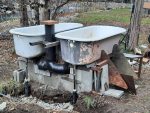 In the accompanying photos, you’ll see I’ve incorporated steel tubing and a steel-hinged door attached to the foundation. I have an iron and fabrication background and any excuse I have to tweak or “improve” something I will. The guidelines I’ve shared are to give you a sound cowboy hot tub without doing any welding. Next, (we’re almost there), get a piece of roofing tin or 16 gauge steel plate 20 inches by 20 inches. This will be the door to contain the fire on the open side of the “C” of the tub. Get a pair of tin shears from Harbor Freight to trim the steel to fit the hole. Maybe pick up a metal handle to a kitchen drawer and screw it to the tin piece. This will give you something to grab onto when you remove the tin sheet to feed wood into the fire.
In the accompanying photos, you’ll see I’ve incorporated steel tubing and a steel-hinged door attached to the foundation. I have an iron and fabrication background and any excuse I have to tweak or “improve” something I will. The guidelines I’ve shared are to give you a sound cowboy hot tub without doing any welding. Next, (we’re almost there), get a piece of roofing tin or 16 gauge steel plate 20 inches by 20 inches. This will be the door to contain the fire on the open side of the “C” of the tub. Get a pair of tin shears from Harbor Freight to trim the steel to fit the hole. Maybe pick up a metal handle to a kitchen drawer and screw it to the tin piece. This will give you something to grab onto when you remove the tin sheet to feed wood into the fire.

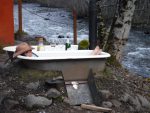 Now the last part that needs to be installed is the chimney pipe. You will need a 6-inch single-walled stove pipe 36” inches long, two 90 degree elbows for the 6-inch stove pipe, and a short piece of 6-inch stove pipe 12 inches long. Attach the 12 inch pipe to one of the elbows. After these are attached, attach this assembly to the “36” inch stove pipe. It should be in the shape of a capital “L”. Place the short part of the “L” into the 6” by 8” hole in the firebasin box at the drain end of the tub. Keeping the chimney in the straight vertical position fill dirt around the tubs. The dirt will lock the chimney pipe in place. Continue to fill dirt around the tubs until the dirt level reaches at least half the tub height. Do not fill dirt in the firebox entrance. That is where the tin door goes.
Now the last part that needs to be installed is the chimney pipe. You will need a 6-inch single-walled stove pipe 36” inches long, two 90 degree elbows for the 6-inch stove pipe, and a short piece of 6-inch stove pipe 12 inches long. Attach the 12 inch pipe to one of the elbows. After these are attached, attach this assembly to the “36” inch stove pipe. It should be in the shape of a capital “L”. Place the short part of the “L” into the 6” by 8” hole in the firebasin box at the drain end of the tub. Keeping the chimney in the straight vertical position fill dirt around the tubs. The dirt will lock the chimney pipe in place. Continue to fill dirt around the tubs until the dirt level reaches at least half the tub height. Do not fill dirt in the firebox entrance. That is where the tin door goes.
To make it a special place, we spread wildflower seeds into the dirt when setting our tubs.
Light a wood fire in the firebox and look for any smoke leaks. If there are any leaks, then fill the cracks with dirt, rocks, or mortar. Put the last elbow on top of the chimney to guide the smoke away from you.
The bottom of the tub will be hot when you get in to take a bath. Cut a small piece of 3/8 plywood for your fanny and a piece for your feet. We’ve also used wood fencing lattice work to place at the bottom of the tub.
I hope this gives you something to consider in your preps. I think the Father is getting ready to close the door on the Ark.
Love and Freedom in Christ, – A Bielski Brother

